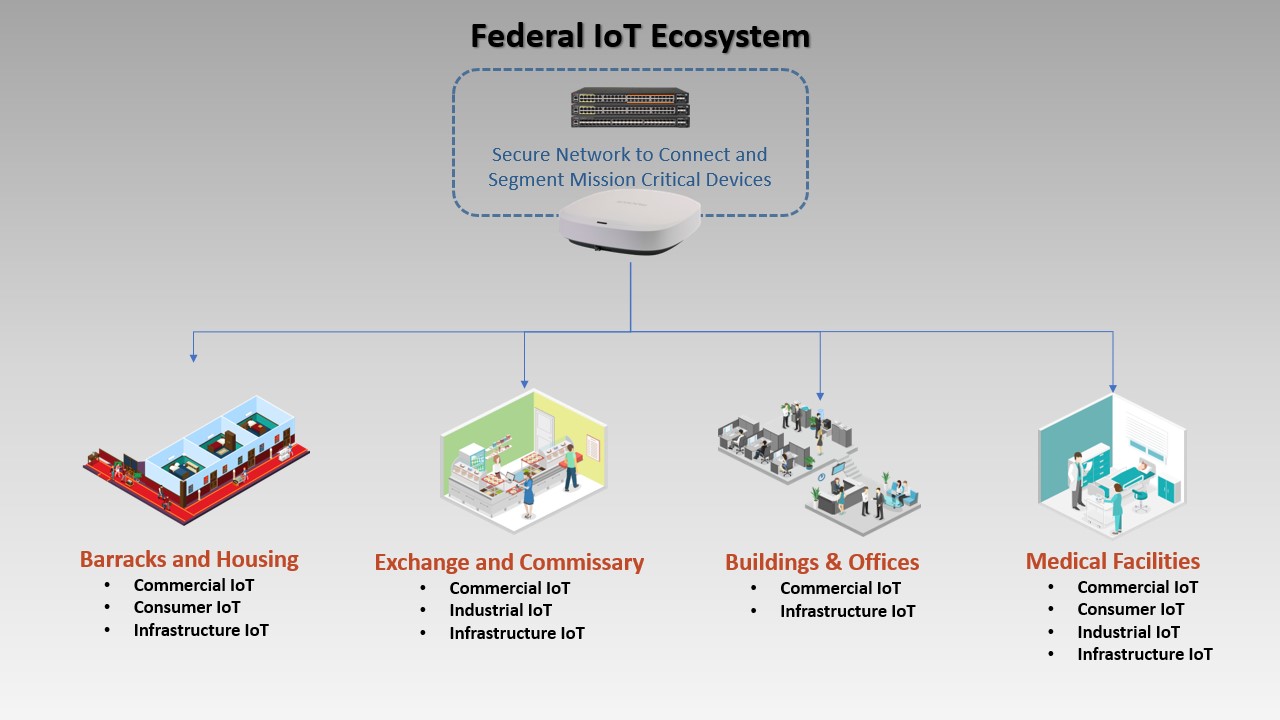Welcome to RUCKUS Networks, part of CommScope's world-leading portfolio of networking solutions. Learn more.
Wireless Technologies Are Converging for IoT Networks
In the previous two installments of this blog series, we explored the challenges federal agencies face as they deploy a secure infrastructure to support new internet of things (IoT) use cases. The first part identified vulnerabilities in IoT devices, emphasizing the risk posed by insecure networks. The second part demonstrated how RUCKUS® solutions, particularly ICX® switches, address these challenges. In this blog, we’ll talk about wireless connectivity technologies and solutions.

RUCKUS access points (APs) stand out for their innovative design, serving as converged radio points that seamlessly integrate Wi-Fi® and IoT technologies. They support multiple wireless standards concurrently, including Wi-Fi standards as well as IoT-specific protocols like Bluetooth® Low Energy (BLE) and Zigbee®. This consolidation eliminates the need for separate infrastructure—simplifying network management, reducing complexity, and cutting deployment and maintenance costs. Intelligent antennas and advanced beamforming technologies optimize signal transmission, providing robust coverage and reliable connectivity for both Wi-Fi clients and IoT devices.
RUCKUS solutions also provide centralized management—simplifying configuration and troubleshooting. Their unique combination of convergence and control makes RUCKUS APs ideal for IoT deployments, enabling federal agencies to enhance operational efficiency, reduce costs, and take advantage of a unified solution for deploying and managing wireless networks for a diverse range of devices.
IoT deployments can also benefit from AP containerization. This technology lets multiple applications operate on a single AP, optimizing AP usage and reducing deployment requirements. RUCKUS has integrated AP containerization into its IoT Suite. RUCKUS IoT Suite facilitates multi-standard wireless access, catering to both Wi-Fi and non-Wi-Fi IoT endpoints. It strengthens security by isolating device applications as containers, which inherently prevent the invasion of malicious actors from affecting other containers within the WLAN. Organizations can define security permissions to automatically block unwanted traffic from entering containers, or limit communications with unnecessary resources as an additional form of network segmentation.
To further enhance the security and compliance of IoT networks, RUCKUS SmartZone™ controllers integrate advanced Wi-Fi security features. With WPA3 encryption and 802.1X authentication, it applies robust encryption and access control. RADIUS integration enhances authentication processes, while RBAC and guest access controls limit access rights for devices. WIDS/WIPS capabilities detect and prevent unauthorized access, and client isolation reduces vulnerability risks. Device fingerprinting aids policy enforcement, and VLAN supports segment traffic for IoT devices, containing breaches. Security certificates, rogue AP detection, and Dynamic PSK™ (pre-shared keys) technology further enhance authentication and detection. Application visibility, MAC filtering, and a comprehensive security suite work together to provide a secure, resilient, and controlled environment for connected devices.
Wi-Fi 6 vs. Wi-Fi 6E vs. Wi-Fi 7
Wi-Fi technology has matured over the past two decades, and a variety of options are available—each with their own advantages. Wi-Fi 6, also known as 802.11ax, brings several enhancements beneficial to IoT deployments. One of the key features is Target Wake Time (TWT). TWT allows devices to negotiate when and how often they will wake up to send or receive data, significantly improving network efficiency and reducing power consumption. This is particularly advantageous for IoT devices, which often operate on battery power. By scheduling transmissions, devices can remain in sleep mode longer, extending battery life. This makes Wi-Fi 6 a compelling choice for IoT applications, particularly those that do not require immediate responses or frequent data transmission.
Wi-Fi 6E extends the 802.11ax standard into the 6 GHz band, providing significant increases in available bandwidth. However, it’s important to note that most IoT devices still utilize the 2.4 GHz band. While Wi-Fi 6E includes the same improvements as Wi-Fi 6, it can be more costly while using the 6 GHz band with standard power. Wi-Fi 6E requires Automated Frequency Coordination (AFC) in addition to Category 6A cabling and multi-gigabit switching to fully benefit from the increased power draw required from Wi-Fi 6E APs. Furthermore, there are key technologies discussed below, that are missing from Wi-Fi 6E, which prevent efficient use of the increased spectrum.
Wi-Fi 7, also known as 802.11be, introduces several advancements for IoT deployments, such as multi-link operation (MLO) and Punctured Transmission. MLO allows devices to establish multiple links across different bands (2.4 GHz, 5 GHz, and 6 GHz) simultaneously. This increases throughput, reduces latency, and improves reliability. Punctured Transmission, on the other hand, allows devices to utilize bandwidth effectively even in the face of narrow band interference, offering more stable and high-speed connectivity. These features make Wi-Fi 7 a compelling choice for IoT applications. However, to fully benefit from these enhancements, it is important to note that the network will require Cat 6A cabling and multi-gigabit switching.
Empowering agencies with secure connectivity—everywhere
A secure network infrastructure is pivotal for efficient communication and collaboration within facilities management groups for federal agencies, especially when integrated with IoT devices in all deployment types. This integration allows for streamlined operations, proactive maintenance, and the creation of intelligent building ecosystems. The right infrastructure equipment is essential to securing diverse IoT devices and protecting sensitive data from agencies and their constituents. Investing in advanced networking, tailored for IoT needs, provides scalability and future-proofing. It can help facilities management groups justify their costs, while positioning them to unlock improved operations, data-driven decision-making, and enhanced security, while empowering their agencies to achieve mission-critical objectives.
For more information on edge network solutions for federal agencies, visit our industry solutions page.
This series continues
Did you miss Part 1 and Part 2? Go back and learn more about RUCKUS® solutions—particularly ICX® switches- that address the challenges of vulnerable networks. Then read on to the next chapter, which demonstrates how RUCKUS® solutions—particularly ICX® switches- address these challenges.
Get ahead with RUCKUS Networks!
Sign up for exclusive insights from RUCKUS Networks.
© 2024 CommScope, LLC. All rights reserved. CommScope and the CommScope logo are registered trademarks of CommScope and/or its affiliates in the U.S. and other countries. For additional trademark information, see https://www.commscope.com/trademarks. Wi-Fi, Wi-Fi 6, Wi-Fi 6E, and Wi-Fi 7 are trademarks of the Wi-Fi Alliance. Bluetooth is a trademark of Bluetooth SIG, Inc. Zigbee is a trademark of the Connectivity Standards Alliance. All product names, trademarks and registered trademarks are property of their respective owners.












